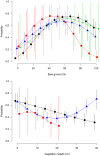Patches of bare ground as a staple commodity for declining ground-foraging insectivorous farmland birds
- PMID: 20949083
- PMCID: PMC2950849
- DOI: 10.1371/journal.pone.0013115
Patches of bare ground as a staple commodity for declining ground-foraging insectivorous farmland birds
Abstract
Conceived to combat widescale biodiversity erosion in farmland, agri-environment schemes have largely failed to deliver their promises despite massive financial support. While several common species have shown to react positively to existing measures, rare species have continued to decline in most European countries. Of particular concern is the status of insectivorous farmland birds that forage on the ground. We modelled the foraging habitat preferences of four declining insectivorous bird species (hoopoe, wryneck, woodlark, common redstart) inhabiting fruit tree plantations, orchards and vineyards. All species preferred foraging in habitat mosaics consisting of patches of grass and bare ground, with an optimal, species-specific bare ground coverage of 30-70% at the foraging patch scale. In the study areas, birds thrived in intensively cultivated farmland where such ground vegetation mosaics existed. Not promoted by conventional agri-environment schemes until now, patches of bare ground should be implemented throughout grassland in order to prevent further decline of insectivorous farmland birds.
Conflict of interest statement
Figures

References
-
- Robinson RA, Sutherland WJ. Post-war changes in arable farming and biodiversity in Great Britain. J Appl Ecol. 2002;39:157–176.
-
- Benton TG, Vickery JA, Wilson JD. Farmland biodiversity: is habitat heterogeneity the key? Trends Ecol Evol. 2003;18:182–188.
-
- Britschgi A, Spaar R, Arlettaz R. Impact of grassland farming intensification on the breeding ecology of an indicator insectivorous passerine, the Whinchat Saxicola rubetra: Lessons for overall Alpine meadowland management. Biol Conserv. 2006;130:193–205.
-
- Vickery JA, Tallowin JR, Feber RE, Asteraki EJ, Atkinson PW, et al. The management of lowland neutral grassland in Britain: effects of agricultural practices on birds and their food resources. J Appl Ecol. 2001;38:647–664.
Publication types
MeSH terms
LinkOut - more resources
Full Text Sources

